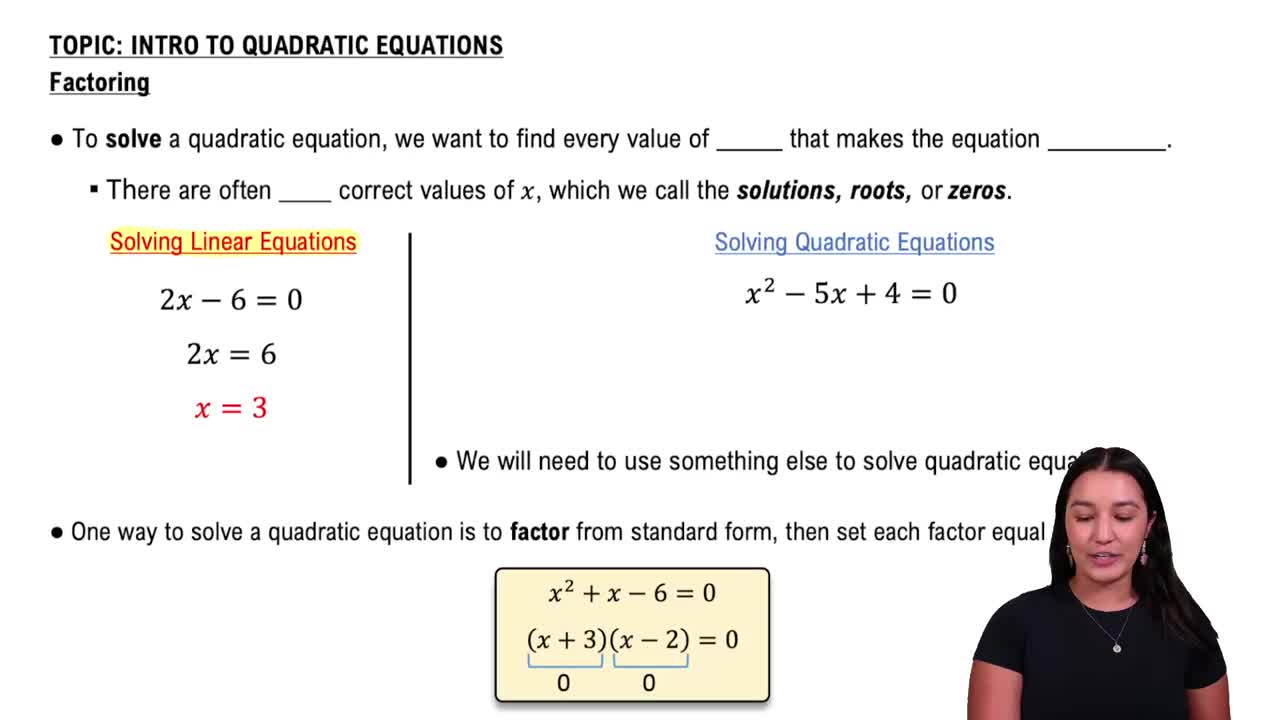Table of contents
- 0. Review of Algebra4h 16m
- 1. Equations & Inequalities3h 18m
- 2. Graphs of Equations43m
- 3. Functions2h 17m
- 4. Polynomial Functions1h 44m
- 5. Rational Functions1h 23m
- 6. Exponential & Logarithmic Functions2h 28m
- 7. Systems of Equations & Matrices4h 6m
- 8. Conic Sections2h 23m
- 9. Sequences, Series, & Induction1h 19m
- 10. Combinatorics & Probability1h 45m
1. Equations & Inequalities
Intro to Quadratic Equations
Problem 174
Textbook Question
Write a quadratic equation in general form whose solution set is {- 3, 5}.
 Verified step by step guidance
Verified step by step guidance1
Start with the fact that if a quadratic equation has solutions \(x = a\) and \(x = b\), it can be expressed in factored form as \((x - a)(x - b) = 0\).
Substitute the given solutions into the factored form: \((x + 3)(x - 5) = 0\).
Expand the factored form by using the distributive property (also known as FOIL for binomials): \(x(x - 5) + 3(x - 5)\).
Simplify the expression by distributing: \(x^2 - 5x + 3x - 15\).
Combine like terms to write the quadratic equation in general form: \(x^2 - 2x - 15 = 0\).
Recommended similar problem, with video answer:
 Verified Solution
Verified SolutionThis video solution was recommended by our tutors as helpful for the problem above
Video duration:
2mPlay a video:
Was this helpful?
Key Concepts
Here are the essential concepts you must grasp in order to answer the question correctly.
Quadratic Equation
A quadratic equation is a polynomial equation of degree two, typically expressed in the form ax² + bx + c = 0, where a, b, and c are constants and a ≠ 0. The solutions to this equation, known as the roots, can be found using various methods such as factoring, completing the square, or the quadratic formula.
Recommended video:

Introduction to Quadratic Equations
Roots of a Quadratic Equation
The roots of a quadratic equation are the values of x that satisfy the equation, meaning they make the equation equal to zero. For a quadratic with roots r₁ and r₂, the equation can be expressed in factored form as a(x - r₁)(x - r₂) = 0. In this case, the roots are given as -3 and 5.
Recommended video:

Solving Quadratic Equations by the Square Root Property
General Form of a Quadratic Equation
The general form of a quadratic equation is represented as ax² + bx + c = 0. To write a quadratic equation in this form given its roots, one can use the factored form and expand it. For roots -3 and 5, the equation can be derived by multiplying the factors (x + 3)(x - 5) and then rearranging it into the general form.
Recommended video:

Introduction to Quadratic Equations

 5:35m
5:35mWatch next
Master Introduction to Quadratic Equations with a bite sized video explanation from Callie
Start learningRelated Videos
Related Practice










